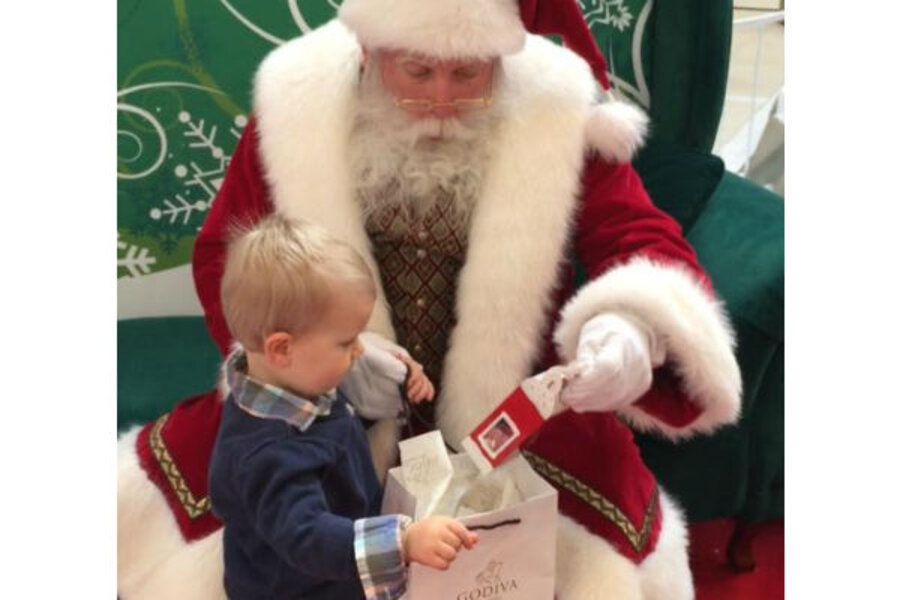The gift for Santa: Putting giving in the hands of kids
Loading...
It’s not every day you see a little boy giving a gift to Santa, but on a recent trip to a New Jersey mall, Kristina Lind’s son did just that. Children often get a case of the “gimmies” this time of year.
Swayed by pop music, TV, movies, and advertisements, the desire for everything from toys to junk food can seem endless. As shown in the documentary “Consuming Kids,” children under the age of 12 influence adult spending by around $700 billion a year. To put that into perspective, $700 billion would pay every US household's heating bill for 5 years.
During the holiday season in particular, commercialism is perpetuated by “Hot Toy Lists,” “Best Sellers,” and “Most Popular” items that encourage parents to spend.
This year, as the holidays approach and shoppers rush to the mall to buy gifts for everyone on their list, some parents are choosing to take the emphasis off commercialism and find the real spirit of the season by teaching their children all about gratitude and giving.
A study published in the School Psychology Review indicated that when children take the time to recognize their blessings, the feelings of appreciation can increase. By shifting the focus off materialism to benevolence many parents are discovering their children get a sense of satisfaction and self-confidence that money just can’t buy.
During one test for the study performed on toddlers, treats such as small crackers or cookies were given to them to enjoy. After a warm-up period, the toddlers were introduced to puppets who “liked treats.” The experimenters took from the toddler’s treats and gave them to the puppets. When the puppets reacted with “Yum!” or obvious satisfaction, the toddlers often gave away their treats to the puppets. The participants' happiness was measured throughout the experiment and revealed the toddlers were most content when they gave their treats to the puppets.
Ms. Lind from Princeton, N.J., a mother of two, is using the spirit of the season to teach her oldest son, though only 19 months old, the importance of giving with something he can relate to outside of his home. On a recent visit to the mall, they bumped into Santa who wasn’t sitting on his usual perch like most Santas do. Instead, the mall Santa was seeking out the children and saying hello as he walked around his set of the North Pole. His kindness was so evident and Lind decided to come back the next day to have the kids’ picture taken with him.
She thought about all the kindness and giving that Santa expresses that she realized no one gives back to Santa. She couldn’t resist the opportunity to teach her son a lesson in giving. So before they waited in line to visit Santa, they stopped at the Godiva Chocolate store across the way.
“What Santa doesn’t like chocolate?” Lind joked. Lind knew her son loved chocolate too and it was the perfect choice. As Santa took the little boy’s hand, he handed him the gift, leaving the older gentleman in disbelief, but with a smile on his face.
“In the years to come we will be encouraging him to give through local programs such as at a soup kitchen and giving to those in need. Santa was just a starting place for us this year,” says Lind.
Leslie Wall, of Portland, Ore. has taken her boys, ages 5 and 8, to a local nursing home during Christmas time for the past three years. Along with their Golden Retriever, Pepper, they visit the residents who may not have family close by or just need a little cheering up.
“It is so important to me that my boys learn to give back. Yes, they ask for the most popular toys, but they are also very aware of what it means to be selfless and help others,” says Ms. Wall
Both Lind and Wall hope to create a lifetime of awareness by teaching their children early on the importance of charitable giving [and the holidays offer a perfect opportunity for that]. Lind is already seeing the benefits. “Whether it’s helping me with the laundry, even if it’s just throwing a sock in the dryer, or offering to share toys with his sister, he is already embracing compassion and generosity,” says Lind.
While the holidays offer a good starting point for talking with kids about gratitude and giving to others, a year-round donation of one’s time can be the next step in solidifying a child’s sense of kindness and giving. Kristin Leung of Ewing, N.J., is teaching her teen daughter the importance of giving back during the holiday season and all year long.
She and her teenage daughter volunteer their time at a local animal shelter. From cleaning out litter boxes and cages to helping socialize the animals, they volunteer during a time of the year when help is scarce. “I’m just doing my best to raise my daughter to be a kind person,” says Ms. Leung. Leung and her daughter are taking steps to certify their cats to be therapy pets so they can be comforting companions at nursing homes.
Instilling gratitude and altruism in children and teenagers can bring new meaning to the holidays for them. With endless opportunities to give back to their communities this season, the holidays are sure to be a little brighter.







